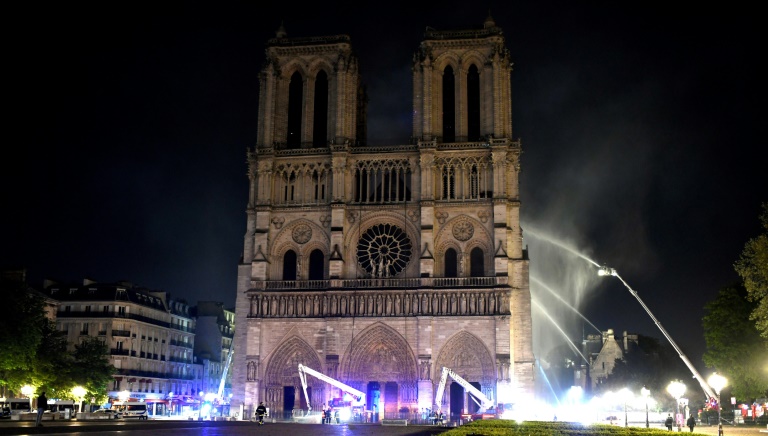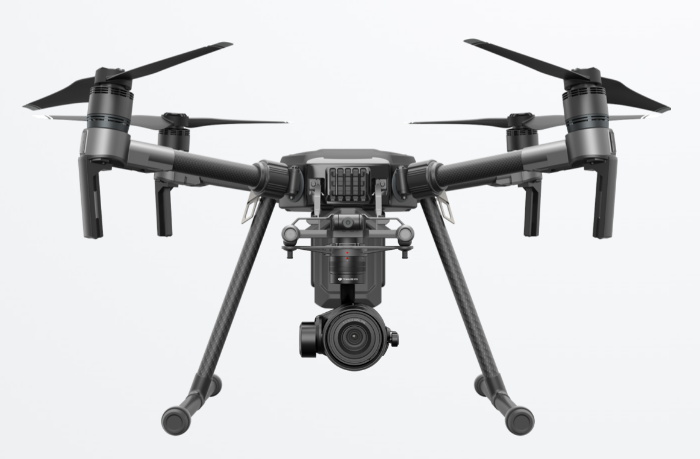Drones and robots that helped save the Notre Dame Cathedral in Paris

In the era of social networks for such events as the fire in the cathedral of Notre Dame, the global audience is watching in real time. From New York to Tokyo, millions of people have stuck to their smartphones and computers, waiting for the latest updates from the media and individuals who have documented the fire from the scene. Twelve harsh hours the fate of the 850-year-old icon of Paris hung in the balance, and for a while it seemed that the worst could not be avoided.
The fire was completely extinguished, the smoke cleared, and in the light of the day we find out what heroic accomplishments the rescue services had to go to in order to avoid a complete disaster. And although the cathedral was seriously damaged, its structure and most of the priceless works of art survived. It is too early to estimate how much cleaning and repair of the cathedral will cost, but even the most optimistic estimates speak of hundreds of millions of dollars. In the case of such an old structure, its reconstruction will probably slow down due to the fact that historians will have to re-examine the construction technologies used over the past centuries and are outdated by today. But the French people will not be scared away, and President Macron has already promised that his country will restore the cathedral in five years.
It is impossible to overestimate the importance of the actions of men and women who risked their lives to save one of the most beloved monuments of France. They deserve praise from the grateful people of the country and the whole world. But advanced technologies also fought with them, some of which went into service immediately after notification. These vehicles helped guide firefighters in their battle with raging flames, and replaced people in case of too much risk. As a result, not the machines coped with the fury of nature, but people; but if it were not for the use of modern technology, the damage could be much more.
')
Top view
As written in the French media , rescue services used at least two UAVs to inspect the burning cathedral. Thanks to the images, firefighters could monitor the intensity and movement of fire in real time. Using drones was not only faster and cheaper than helicopters - their operators could fly closer to the fire, because they were not so much afraid of fire and smoke, like a manned aircraft that would keep at a distance from fire.

Mavic pro
However, it turned out that the Paris firefighters actually did not have their UAVs for use in such situations. They borrowed two commercially available copies, which were used by the Ministry of the Interior and the Ministry of Culture. Both quadcopter models, Mavic Pro and Matrice M210, are manufactured by the Chinese company DJI. The products of this manufacturer practically personifies the segment between consumer and professional platforms for aerial photography [prosumer - from professional (professional) and consumer (consumer) / approx. trans.], and this company also produces the extremely popular Phantom series of drones.
Mavic Pro is a small semi-autonomous quadrocopter, which DJI advertises as an ideal device for spontaneous shooting of high-quality video, because it can be folded, making it much easier to transport it, compared to traditional quadcopters. Its flight time is up to half an hour, the camera with a resolution of 4K has a gimbal for three-axis stabilization, and it can automatically track objects selected by the operator in the frame and rotate around them - as a result, it is ideal for viewing fire from above.

Matrice M210
Unlike Mavic, Matrice M210 belongs to the line of professional quadrocopters from DJI. It is larger and more powerful, and is designed to carry payloads such as spotlights, thermal imagers and cameras with optical zoom. Regarding whether the imager was installed on the M210, which was used by Parisian firefighters, there are conflicting reports, but in any case, it still gave them another source of high-definition video.
It is interesting to note that in general in Paris it is strictly forbidden to use drones, and the function of supporting “geographic barriers” built into DJI products would not allow them to fly over Notre Dame. However, the DJI system allows operators to send requests for the temporary lifting of restrictions , which allowed the manufacturer to quickly work together with the French authorities and allow UAV flights due to the seriousness of the situation.
On the shoulders of the Colossus
If consumer equipment coped with its task in the sky, then on earth the situation was too difficult for beginners. To penetrate the cathedral and try to fight the fire from the inside, the Paris firefighters used the Colossus. This 500-pound tracked platform , developed by Shark Robotics, is in fact fire resistant and watertight, and together with a motorized water cannon, is a powerful asset for fighting fire.
The Colossus was particularly useful during the fire fighting in Notre Dame, since it was able to remain inside the structure when the roof was already enveloped in fire. When burning fragments fell from above, and then the inevitable collapse of the cult spire of a structure consisting of lead and wood occurred, the interior of the cathedral was a particularly dangerous place for live firefighters. The Colossus was able to provide a steady stream of water in the nave, even when the entire building literally fell apart around it. The final cooling effect has already been called the main factor, thanks to which the priceless stained glass windows were saved. In addition, he gave the firemen another real-time video stream, and they were able to determine the safe moment when additional commands could be sent inside.
High tech recovery
Advanced technologies and robots have played their part in saving the cathedral, and, apparently, their work is not yet finished. As we saw during previous disasters, for example, the accident at the Fukushima nuclear power plant , robots can be used to study the structural integrity in places too dangerous for humans. From the air, drones with high-resolution cameras will be able to quickly get images of the entire structure, and this can be helped in creating a three-dimensional model of the building using photogrammetry ; so it will be possible to design a modern roof that blends with the original stonework.
To restore Notre Dame in such an ambitious period as the five years set by President Macron, without neglecting the safety of the thousands of workers who will be employed in this project, no help will be rejected. The French people are excited by this event, and before the end of this project we may still see new advanced solutions specially designed to overcome the unique difficulties associated with this reconstruction. The fire at Notre Dame can be called a historical tragedy, but the lessons we have learned can be of such benefit to the world as it is difficult for us to imagine today.
Source: https://habr.com/ru/post/448734/
All Articles